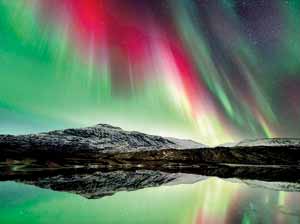Most people dream of watching the world's most stunning light display at least once in their lifetime but for one photographer it is a nightly occurrence.
Tommy Eliassen spends his nights chasing auroras around his home town of Mo i Rana in Norway to capture them in all their glory and has even created a timelapse video to give others a taste of his experiences.
 |
| Wonder of the skies: The spectacular Northern Lights turn the sky green over Otter¯y, Nord-Tr¯ndelag, in Norway, |
Far from getting bored of watching the northern lights, Eliassen says it's a delight every time.
He said: 'We're used to seeing the aurora, but I can understand why people travel around the world to see them.
'After years of photographing this natural phenomenon I still find it beautiful and fascinating every time.'
Eliassen, 34, started his photography career in the late 1990s and works in salmon vaccination which allows him to travel around the north of the country.
He said: 'Since the beginning I've been interested in night, landscape and long exposure photography.
'But in recent years I've become more and more involved in astro and aurora photography. I guess it's because I'm lucky enough to live just under the Arctic Circle - you can't really avoid the aurora here.'
Mo i Rana is located 50 miles south of the Arctic Circle and temperatures can drop below -20C in the winter. Eliassen always goes out alone to take his photographs and has to be well organised ahead of his trips.
He said: 'There is a bit of planning involved. I always keep up to date on the weather forecast and the sun activity. 'One of the most challenging things is that you never know exactly when and where the outbursts will happen. It changes in latitudes and intensity within seconds.'
The northern lights, or Aurora Borealis, form when charged particles from the sun penetrate the earth's magnetic field and collide with atoms and molecules to create bursts of light.
'Collisions with oxygen produce red and green auroras, while nitrogen produces the pink, blue and purple skies,' he added.
This year's aurora season starts again in late August and is predicted to be one of the best yet.
'The solar activity is expected to reach a maximum in 2012/2013 so we can look forward to many strong aurora displays.'
The Aurora Borealis is most commonly spotted in Norway but recently solar activity has been increasing with the light show visible in the skies above the UK in January.
© Daily Mail, London |


